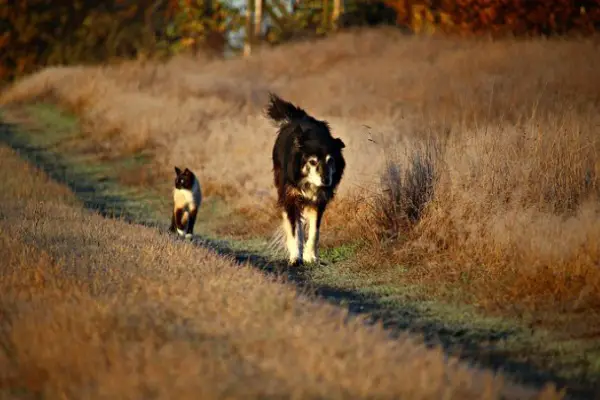Social Aggression in Dogs [Causes, Signs & Fix]
![Social Aggression in Dogs [Causes, Signs & Fix] Social Aggression in Dogs](https://petcreeks.com/wp-content/uploads/2023/10/pexels-yan-krukau-5792905.jpg)
Today, let’s dive into a topic that can be a bit of a puzzle: social aggression in dogs. We all want our furry friends to get along and make new pals, but sometimes their social interactions can take an unexpected turn.
In this article, we’ll unpack the causes, signs, and tips on how to handle social aggression in our beloved canine companions.
So grab a cup of coffee and let’s get started!
What is Social Aggression in Dogs?
Social aggression in dogs refers to aggressive behavior displayed towards other dogs or animals within a social context.
It can include behaviors such as growling, snapping, lunging, or biting, and is often motivated by competition for resources, territoriality, or social hierarchy.
Social aggression can be a result of inadequate socialization, fear, or underlying behavioral issues, and it is important for dog owners to address and manage this behavior through proper training and behavior modification techniques.
Read more about different forms of aggression in dogs.
Signs of Social Aggression in Dogs
Here are some of the most common signs of social aggression in dogs:
Growling and Snarling: Dogs that display social aggression may growl or snarl when they encounter other dogs. This is a warning sign that they are feeling threatened or uncomfortable and may escalate to more aggressive behavior if not addressed.
Lunging and Barking: Dogs exhibiting social aggression may lunge towards other dogs while barking. This behavior is an attempt to intimidate or establish dominance over the other dog. It is important to intervene and redirect their attention to prevent any potential conflicts.
Stiff Body Language: Dogs displaying social aggression often have a stiff body posture. They may hold their tail high and rigid, with their ears forward and their body tense. This body language indicates that they are ready to defend themselves or assert dominance.
Snapping and Biting: In some cases, dogs with social aggression may snap or bite at other dogs. This aggressive behavior is a clear indication that they are feeling threatened or trying to establish dominance. It is crucial to separate the dogs and seek professional help to address the underlying causes of the aggression.
Resource Guarding: Dogs with social aggression may exhibit resource-guarding behavior, where they become possessive over food, toys, or other valuable items. They may growl, snap, or even attack other dogs that approach their resources. This behavior can lead to conflicts and should be addressed through training and behavior modification.
Dominance Posturing: Dogs displaying social aggression may engage in dominant posturing, such as standing tall, placing their head over the other dog’s shoulder, or mounting. These behaviors are attempts to establish dominance and can lead to confrontations if not managed properly.
Read more about how to know an aggressive dog.
Causes of Social Aggression in Dogs
Social aggression in dogs can have various causes. Here are some of the most common causes of social aggression in dogs:
1. Resource Guarding: Dogs may display social aggression when they feel the need to protect their resources, such as food, toys, or territory. This can lead to aggressive behavior towards other dogs or even humans who approach their resources.
2. Lack of Socialization: Dogs that have not been properly socialized during their critical developmental period may exhibit social aggression. They may feel fearful or threatened by unfamiliar dogs or people, leading to aggressive behavior as a defensive response.
3. Fear and Anxiety: Dogs that experience fear or anxiety in social situations may resort to aggression as a way to protect themselves. This can occur when they feel overwhelmed or threatened by other dogs or unfamiliar environments.
4. Dominance and Hierarchical Issues: Dogs are pack animals and have a natural instinct to establish a hierarchical order. Social aggression can arise when dogs within a household or social group compete for dominance or struggle to establish their position in the hierarchy.
5. Frustration and Lack of Stimulation: Dogs that are not provided with enough mental and physical stimulation can become frustrated, leading to social aggression. This can occur when dogs are confined or lack opportunities for exercise and play.
6. Sexual Issues: Intact male dogs, especially when they are in the presence of a female in heat, may display aggressive behavior towards other male dogs. This aggression is driven by hormonal factors and the desire to compete for mating opportunities.
7. Medical Issues: Some medical conditions, such as pain or hormonal imbalances, can contribute to social aggression in dogs. It’s important to rule out any underlying health issues that may be causing or exacerbating the aggressive behavior.
Read more about some common causes of aggression in dogs.
How to Stop Social Aggression in Dogs
Social aggression in dogs refers to aggressive behavior displayed towards other dogs or people during social interactions. It is important to address and manage social aggression in dogs to ensure the safety of all parties involved.
Here are some ways to stop social aggression in dogs:
1. Early Socialization: Proper socialization is crucial for puppies to learn appropriate behavior and develop positive associations with other dogs and people. Expose your puppy to various social situations, environments, and different types of dogs and people from a young age. This can help prevent the development of social aggression later in life.
2. Create a Safe and Calm Environment:
Creating a safe and calm environment for your dog can help reduce social aggression. Provide your dog with a designated space where they can retreat and feel secure when they need a break from social interactions. Avoid situations that may cause stress or anxiety for your dog, as these can contribute to aggressive behavior. Consistency, routine, and a calm household can also help promote a sense of security and reduce social aggression in dogs.
3. Positive Reinforcement Training: Use positive reinforcement training techniques to teach your dog appropriate behavior and reward them for calm and non-aggressive responses during social interactions. Reward your dog for good behavior, such as sitting or staying calm when encountering other dogs or people.
4. Gradual Exposure and Desensitization: If your dog already displays social aggression, it is important to address the issue gradually and systematically. Start by exposing your dog to controlled and positive social interactions at a distance where they feel comfortable and not reactive. Gradually decrease the distance over time while ensuring your dog remains calm and non-aggressive. This process is known as desensitization and can help your dog develop more positive associations with social interactions.
5. Seek Professional Help: If your dog’s social aggression persists or worsens despite your efforts, it is recommended to seek the assistance of a certified professional dog trainer or a board-certified veterinary behaviorist. They can provide guidance, develop a behavior modification plan tailored to your dog’s specific needs, and help you implement effective strategies to address social aggression.
6. Avoid Triggers and Manage Environments: Identify triggers that may provoke social aggression in your dog and try to avoid or manage those situations. For example, if your dog becomes aggressive when encountering certain types of dogs or in crowded environments, avoid those situations or keep your dog on a leash and maintain a safe distance. Managing the environment can help prevent or minimize the occurrence of social aggression episodes.
Read more about how to stop aggression in dogs.
Consequences of Social Aggression in Dogs
Social aggression in dogs can have several significant consequences, both for the dogs themselves and their owners.
Here are some consequences of social aggression in dogs:
1. Negative Impact on the Dog’s Well-being: Dogs that display social aggression often experience elevated stress levels and anxiety. This can lead to a decrease in their overall well-being and quality of life. They may become more fearful, and reactive, and have difficulty trusting other dogs or people, which can further isolate them socially.
2. Risk of Physical Harm: Dogs exhibiting social aggression may engage in aggressive behaviors such as biting, growling, lunging, or snapping at other dogs. This increases the risk of physical harm to both the aggressor and the recipient of the aggression. Such encounters can result in injuries that may require medical attention and negatively impact the dog’s health.
3. Difficulty in Establishing Positive Social Interactions: Dogs with social aggression find it challenging to form positive relationships with other dogs. This can limit their ability to engage in appropriate social interactions, leading to isolation and a lack of opportunities for mental and physical stimulation. As a result, these dogs may struggle with basic obedience training and have difficulty participating in dog-related activities.
4. Emotional Strain for Dog Owners: Dealing with a socially aggressive dog can be emotionally taxing for owners. Witnessing their dog displays aggressive behaviors can be distressing and cause feelings of helplessness, guilt, and frustration. Owners may also experience social isolation, as they may be hesitant to socialize their dog or may face judgment from others due to their dog’s behavior.
5. Impact on Lifestyle and Activities: Social aggression in dogs can restrict the activities and lifestyle of both the dog and the owner. Owners may need to limit their dog’s interactions with other dogs, avoid crowded areas, or modify their daily routine to accommodate their dog’s needs. This can impact the owner’s ability to participate in social events, and outdoor activities, or even find suitable daycare or boarding options for their dog.
6. Legal Consequences: Social aggression in dogs can lead to legal consequences for owners. If their dog injures another dog or person due to social aggression, owners may be held liable for the damages caused. This can result in legal battles, financial burdens, and potential restrictions on dog ownership in the future.
Preventing Social Aggression in Dogs
The following are some of the most common ways of preventing social aggression in dogs:
1. Proper Socialization
Proper socialization is crucial in preventing social aggression in dogs. It involves exposing dogs to a variety of people, animals, places, and experiences from a young age.
This helps them develop positive associations and learn appropriate behaviors in different social situations. Socialization should be a gradual process, starting with controlled interactions and gradually increasing exposure to new environments and stimuli.
2. Obedience Training
Obedience training is an essential tool in preventing social aggression. Training helps establish a strong bond between the dog and the owner, promotes good behavior, and teaches the dog to respond to commands.
A well-trained dog is more likely to exhibit appropriate social behaviors and can be easily managed in social situations.
3. Positive Reinforcement
Using positive reinforcement techniques, such as rewards and praise, can help prevent social aggression in dogs.
Rewarding desired behaviors encourages dogs to repeat them while avoiding punishment or negative reinforcement helps create a positive and trusting relationship between the dog and the owner.
Positive reinforcement can be used during socialization and obedience training to reinforce good behavior.
4. Early Intervention
Addressing any signs of aggression or problematic behavior early on is crucial in preventing social aggression. It’s important to observe and understand the dog’s body language and behavior cues to identify any potential issues.
If aggression or problematic behavior is noticed, seeking professional help from a qualified dog behaviorist or trainer can provide guidance on how to address and manage the behavior effectively.
5. Environmental Management
Creating a safe and controlled environment for the dog can help prevent social aggression.
This includes providing a secure and comfortable living space, proper confinement when necessary, and avoiding situations that may trigger aggression.
Managing the dog’s environment can help reduce stress and prevent potential conflicts with other dogs or people.
6. Consistent and Clear Communication
Consistent and clear communication between the owner and the dog is essential in preventing social aggression. Dogs need to understand what is expected of them and what behaviors are acceptable.
Using clear verbal cues, hand signals, and body language can help convey expectations and reinforce positive behaviors. Consistency in training and communication helps dogs feel secure and reduces the likelihood of social aggression.
Frequently Asked Questions
Why do some dogs display social aggression?
There are several factors that can contribute to social aggression in dogs. It can be a result of past traumatic experiences, lack of socialization during the critical development period, or even genetic predisposition. In some cases, dogs may display social aggression as a means of protecting their territory or resources.
How can social aggression be managed or prevented?
Managing and preventing social aggression requires a multi-faceted approach. Proper socialization from an early age is crucial, exposing dogs to various environments, people, and other animals. Positive reinforcement training techniques, such as reward-based training, can also help modify aggressive behaviors. Consulting with a professional dog trainer or behaviorist is recommended for tailored guidance.
Can social aggression in dogs be cured?
While social aggression can be challenging to overcome completely, it can be managed and improved with proper training, behavior modification, and consistent guidance. Patience, consistency, and positive reinforcement are key components of successfully addressing social aggression in dogs.
Are certain breeds more prone to social aggression?
While any breed of dog can display social aggression, some breeds may have a higher propensity for it due to their genetic predisposition or history of selective breeding. However, it’s important to remember that each dog is an individual, and their behavior is influenced by a combination of genetics, upbringing, and environment.
Is it safe to introduce an aggressive dog to other animals or people?
Introducing an aggressive dog to other animals or people should be done under the guidance of a professional trainer or behaviorist. It is essential to prioritize safety and ensure that the introduction is done gradually and in a controlled environment. This helps minimize the risk of any negative incidents and allows for proper behavior modification and desensitization techniques to be implemented.
Conclusion
In conclusion, understanding social aggression in dogs is crucial for responsible pet ownership.
By recognizing the signs and triggers of this behavior, we can create a safe and harmonious environment for both our furry friends and those around them.
Let’s work together to promote empathy, training, and proper socialization to ensure a happy and balanced canine community.






